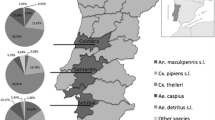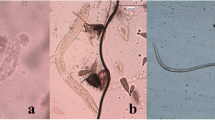Abstract
Recently, dermal microfilariae of a Cercopithifilaria species (Spirurida, Onchocercidae), namely Cercopithifilaria bainae , were detected in dogs from several geographical areas of the Mediterranean basin. Evidence from both laboratory and field studies support the role of the brown dog tick, Rhipicephalus sanguineus sensu lato, as an intermediate host of this nematode. In the present study, we investigated the competence of Ixodes ricinus nymphs as vectors of C. bainae. On November 2012, fully engorged nymphs of I. ricinus (n = 174) and R. sanguineus s.l. (n = 10) were collected from a dog infected by C. bainae. The presence of C. bainae in I. ricinus was assessed by both microscopic dissection of specimens and detection of nematode DNA (PCR), at days 3, 10, 20 and 30 (T1–T4) post-collection; due to the small number of specimens available, R. sanguineus s.l. were examined using the same methods at T4 only. No developing larva of C. bainae was detected in I. ricinus specimens at different time points (T1–T4), even if four of these specimens were PCR-positive at T1. Seven out of ten R. sanguineus s.l. were positive for C. bainae third-stage larvae (L3) at both microscopical and molecular analysis at T4. This study indicates that C. bainae does not develop in I. ricinus nymphs, which preclude the role of this tick as an intermediate host of this parasite. Data presented herein provide new insights into the biology of this filarioid species and will lead to a better understanding of the role of different tick species as vectors of nematodes.

Similar content being viewed by others
References
Bain O, Aeschlimann A, Chatelanat P (1982) Report on infective larvae in ticks from the Geneva region which can probably be identified as the dog filarial worm, Dipetalonema grassii. Ann Parasitol 57:643–646
Bain O, Denke AM (1986) Infective stage larvae of a Filarioid: (?) Cercopithifilaria sp. from ticks of bovines in Togo. Ann Parasitol Huma Comp 61:131–135
Bain O, Petit G, Chabaud AG (1986) Cercopithifilaria roussilhoni n.sp., a tick-transmitted filarial parasite of Atherurus africanus in Gabon, and a hypothesis on the evolution of Cercopithifilaria. Ann Parasitol Huma Comp 61:81–93
Bain O, Uni S, Takaoka H (2002) A synthetic look at a twenty year old taxon, Cercopithifilaria; its probable evolution. Monduzzi X. Proc ICOPA. Monduzzi Editore, Italy
Beugnet F, Mariè JL (2009) Emerging arthropod-borne diseases of companion animals in Europe. Vet Parasitol 163:298–305
Brianti E, Otranto D, Dantas-Torres F, Weigl S, Latrofa MS, Gaglio G, Napoli E, Brucato G, Cauquil L, Giannetto S, Bain O (2012) Rhipicephalus sanguineus (Ixodida, Ixodidae) as intermediate host of a canine neglected filarial species with dermal microfilariae. Vet Parasitol 10:330–337
Dantas-Torres F, Chomel BB, Otranto D (2012) Ticks and tick-borne diseases: a one health perspective. Trends Parasitol 28:437–446
Dantas-Torres F, Figueredo LA, Otranto D (2010) Seasonal variation in the effect of climate on the biology of Rhipicephalus sanguineus in southern Europe. Parasitology 138:527–536
Dantas-Torres F, Otranto D (2013) Seasonal dynamics of Ixodes ricinus on ground level and higher vegetation in a preserved wooded area in southern Europe. Vet Parasitol 192:253–258
Dusbábek F (1996) Nymphal sexual dimorphism in the sheep tick Ixodes ricinus (Acari: Ixodidae). Folia Parasitol 43:75–79
Genchi C, Rinaldi L, Mortarino M, Genchi M, Cringoli G (2009) Climate and Dirofilaria infection in Europe. Vet Parasitol 163:286–292
Gray JS, Dautel H, Estrada-Peña A, Kahl O, Lindgren E (2009) Effects of climate change on ticks and tick-borne diseases in Europe. Interdiscip Perspect Infect Dis 2009:593232
Hartelt K, Pluta S, Oehme R, Kimming P (2008) Spread of ticks and tick-borne diseases in Germany due to global warming. Parasitol Res 103:109–116
Larkin MA, Blackshields G, Brown NP, Chenna R, McGettigan PA, McWilliam H, Valentin F, Wallace IM, Wilm A, Lopez R, Thompson JD, Gibson TJ, Higgins DG (2007) ClustalW and ClustalX version 2. Bioinformatics 23:2947–2948
Manilla G (1998) Fauna d’ Italia vol XXXVI Acari: Ixodida. Calderini, Bologna
Otranto D, Brianti E, Dantas-Torres F, Weigl S, Latrofa MS, Gaglio G, Cauquil L, Giannetto S, Bain O (2011) Morphological and molecular data on the dermal microfilariae of a species of Cercopithifilaria from a dog in Sicily. Vet Parasitol 182:221–229
Otranto D, Brianti E, Latrofa MS, Annoscia G, Weigl S, Lia RP, Gaglio G, Napoli E, Giannetto S, Papadopoulos E, Mirò G, Dantas-Torres F, Bain O (2012a) On a Cercopithifilaria sp. transmitted by Rhipicephalus sanguineus: a neglected, but widespread filarioid of dogs. Parasit Vectors 5:1
Otranto D, Latrofa MS, Brianti E, Annoscia G, Parisi A, Dantas-Torres F, Bain O, Gasser RB (2012b) An assessment of genetic variability in the mitochondrial cytochrome c oxidase subunit 1 gene of Cercopithifilaria sp. (Spirurida, Onchocercidae) from dog and Rhipicephalus sanguineus populations. Mol Cell Probes 26:81–89
Otranto D, Dantas-Torres F, Brianti E, Traversa D, Petrić D, Genchi C, Capelli G (2013a) Vector-borne helminths of dogs and humans in Europe. Parasit Vectors 6:16
Otranto D, Varcasia A, Solinas C, Scala A, Brianti E, Dantas-Torres F, Annoscia G, Martin C, Mutafchiev Y, Bain O (2013b) Redescription of Cercopithifilaria bainae Almeida & Vicente, 1984 (Spirurida, Onchocercidae) from a dog in Sardinia, Italy. Parasit Vectors 6:132
Sangioni LA, Horta MC, Vianna MC, Gennari SM, Soares RM, Galvão MA, Schumaker TT, Ferreira F, Vidotto O, Labruna MB (2005) Rickettsial infection in animals and Brazilian spotted fever endemicity. Emerg Infec Dis 11:265–270
Spratt DM, Haicock P (1988) Aspects of the life history of Cercopithifilaria johnstoni (Nematoda: Filarioidea). Int J Parasitol 18:1087–1092
Walker JB, Keirans JE, Horak IG (2000) Genus (Acari, Ixodidae). A guide to the brown ticks of the world. Cambridge University Press, Cambridge
Winkhardt HJ (1980) The larval development of Dipetalonema rugosicauda (syn, Wehrdikmansia rugosicauda) in the tick Ixodes ricinus. II. The development of Dipetalonema rugosicauda in Ixodes ricinus and investigations about the occurrence of the microfilariae in the roe deer (C. capreolus). Z Tropenmed Parasitol 31:21–30, article in German
Acknowledgments
Authors thank Lénaïg Halos and Federic Beugnet (Merial, France) for partially supporting this research and Luciana Aguiar Figueredo for her thorough suggestions on the manuscript.
Author information
Authors and Affiliations
Corresponding author
Rights and permissions
About this article
Cite this article
Ramos, R.A.N., Giannelli, A., Brianti, E. et al. Tick vectors of Cercopithifilaria bainae in dogs: Rhipicephalus sanguineus sensu lato versus Ixodes ricinus . Parasitol Res 112, 3013–3017 (2013). https://doi.org/10.1007/s00436-013-3474-4
Received:
Accepted:
Published:
Issue Date:
DOI: https://doi.org/10.1007/s00436-013-3474-4




